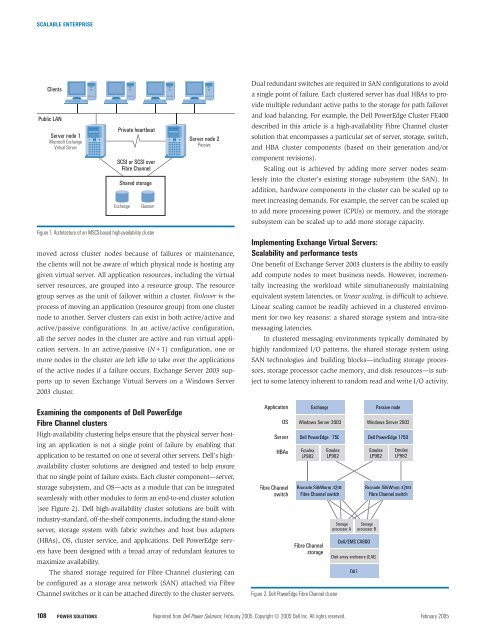Dell Power Solutions
Dell Power Solutions
Dell Power Solutions
- No tags were found...
Create successful ePaper yourself
Turn your PDF publications into a flip-book with our unique Google optimized e-Paper software.
SCALABLE ENTERPRISEClientsPublic LANServer node 1Microsoft ExchangeVirtual Servermoved across cluster nodes because of failures or maintenance,the clients will not be aware of which physical node is hosting anygiven virtual server. All application resources, including the virtualserver resources, are grouped into a resource group. The resourcegroup serves as the unit of failover within a cluster. Failover is theprocess of moving an application (resource group) from one clusternode to another. Server clusters can exist in both active/active andactive/passive configurations. In an active/active configuration,all the server nodes in the cluster are active and run virtual applicationservers. In an active/passive (N+1) configuration, one ormore nodes in the cluster are left idle to take over the applicationsof the active nodes if a failure occurs. Exchange Server 2003 supportsup to seven Exchange Virtual Servers on a Windows Server2003 cluster.Examining the components of <strong>Dell</strong> <strong>Power</strong>EdgeFibre Channel clustersHigh-availability clustering helps ensure that the physical server hostingan application is not a single point of failure by enabling thatapplication to be restarted on one of several other servers. <strong>Dell</strong>’s highavailabilitycluster solutions are designed and tested to help ensurethat no single point of failure exists. Each cluster component—server,storage subsystem, and OS—acts as a module that can be integratedseamlessly with other modules to form an end-to-end cluster solution(see Figure 2). <strong>Dell</strong> high-availability cluster solutions are built withindustry-standard, off-the-shelf components, including the stand-aloneserver, storage system with fabric switches and host bus adapters(HBAs), OS, cluster service, and applications. <strong>Dell</strong> <strong>Power</strong>Edge servershave been designed with a broad array of redundant features tomaximize availability.Private heartbeatSCSI or SCSI overFibre ChannelShared storageExchangeQuorumFigure 1. Architecture of an MSCS-based high-availability clusterServer node 2PassiveThe shared storage required for Fibre Channel clustering canbe configured as a storage area network (SAN) attached via FibreChannel switches or it can be attached directly to the cluster servers.Dual redundant switches are required in SAN configurations to avoida single point of failure. Each clustered server has dual HBAs to providemultiple redundant active paths to the storage for path failoverand load balancing. For example, the <strong>Dell</strong> <strong>Power</strong>Edge Cluster FE400described in this article is a high-availability Fibre Channel clustersolution that encompasses a particular set of server, storage, switch,and HBA cluster components (based on their generation and/orcomponent revisions).Scaling out is achieved by adding more server nodes seamlesslyinto the cluster’s existing storage subsystem (the SAN). Inaddition, hardware components in the cluster can be scaled up tomeet increasing demands. For example, the server can be scaled upto add more processing power (CPUs) or memory, and the storagesubsystem can be scaled up to add more storage capacity.Implementing Exchange Virtual Servers:Scalability and performance testsOne benefit of Exchange Server 2003 clusters is the ability to easilyadd compute nodes to meet business needs. However, incrementallyincreasing the workload while simultaneously maintainingequivalent system latencies, or linear scaling,is difficult to achieve.Linear scaling cannot be readily achieved in a clustered environmentfor two key reasons: a shared storage system and intra-sitemessaging latencies.In clustered messaging environments typically dominated byhighly randomized I/O patterns, the shared storage system usingSAN technologies and building blocks—including storage processors,storage processor cache memory, and disk resources—is subjectto some latency inherent to random read and write I/O activity.Application Exchange Passive nodeOSServerHBAsFibre ChannelswitchWindows Server 2003<strong>Dell</strong> <strong>Power</strong>Edge 1750EmulexLP982Brocade SilkWorm 3200Fibre Channel switchFibre ChannelstorageEmulexLP982Figure 2. <strong>Dell</strong> <strong>Power</strong>Edge Fibre Channel clusterStorageprocessor A<strong>Dell</strong>/EMC CX600Disk array enclosure (DAE)DAEWindows Server 2003<strong>Dell</strong> <strong>Power</strong>Edge 1750EmulexLP982Brocade SilkWorm 3200Fibre Channel switchStorageprocessor BEmulexLP982108POWER SOLUTIONS Reprinted from <strong>Dell</strong> <strong>Power</strong> <strong>Solutions</strong>, February 2005. Copyright © 2005 <strong>Dell</strong> Inc. All rights reserved. February 2005








